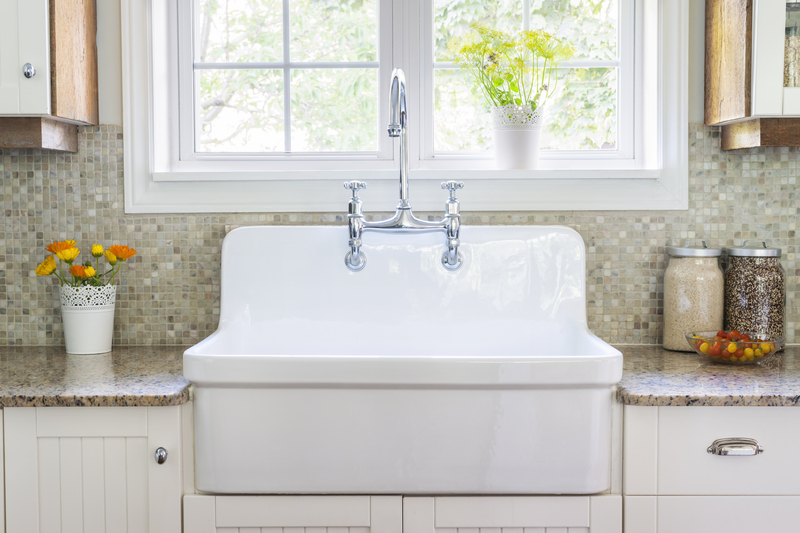How to Effortlessly Clean Mould from Window Sills
Posted on 30/05/2025
How to Effortlessly Clean Mould from Window Sills
Mould on window sills is a common household issue, especially in areas prone to dampness or poor ventilation. If you've discovered unsightly black, green, or brown mold patches growing along your window recesses, you might be wondering how to clean mould from window sills quickly and effortlessly. In this comprehensive guide, you'll learn effective techniques, necessary precautions, prevention strategies, and recommended products--ensuring your windows remain sparkling and your indoor air quality stays pristine.
Why Does Mould Grow on Window Sills?
Understanding the cause of window sill mold is key to keeping it away. Mould thrives in moist, warm environments with poor airflow. When condensation accumulates on your window glass or frames--especially during cold months--the water drips onto sills, creating a perfect breeding ground for fungal spores.
Common Reasons for Mould on Window Frames
- Poor Ventilation: Lack of air movement allows moisture to linger.
- Leaky Windows: Damaged sealant lets rain or dew enter.
- Excess Humidity: Daily activities like cooking and bathing release moisture.
- Condensation: Warm indoor air meets cold glass, leading to water droplets.
- Neglected Cleaning: Dirt and dust provide food for mould spores.
If left untreated, mould on window sills can spread, cause structural deterioration, and even trigger health issues like allergies and respiratory discomfort.

Essential Tools & Materials for Effortless Mould Removal
Before tackling the job, gather the right tools to make the process effortless:
- Protective Gloves and Mask: Protect your skin and lungs from spores.
- Old Toothbrush/Soft Brush: For scrubbing into grooves.
- Microfiber Cloths: Highly absorbent and non-abrasive.
- Spray Bottle: To evenly apply cleaning solutions.
- Cleaning Solution: (More details below--choose store-bought anti-mould spray, diluted bleach, or natural alternatives like white vinegar).
- Bowl or Bucket: For mixing or dipping sponges.
- Paper Towels: To blot up excess moisture.
Tip: Open a window or use a fan for proper ventilation while cleaning to reduce exposure to airborne spores.
Step-by-Step Guide: How to Quickly Clean Mould from Window Sills
Ready to restore your window sills? Follow these easy steps for effortless mould removal:
1. Put on Your Protective Gear
Wear gloves and a mask before you begin. Mould can be hazardous if inhaled or if it comes into contact with skin.
2. Remove Loose Dust and Debris
Start by wiping away dust, dirt, and any loose mould with a dry microfiber cloth. Dispose of this cloth or wash it immediately after use to avoid spreading spores.
3. Apply Your Chosen Mould Removal Solution
There are several cleaning options for removing mould from window sills:
- White Vinegar: Spray undiluted vinegar directly onto the mouldy area. Vinegar is a natural antifungal that kills most types of mould.
- Bleach Solution: Mix 1 part bleach to 10 parts water. Bleach is powerful, but use with caution on painted or wooden surfaces as it may cause discoloration.
- Commercial Mould Remover: These sprays often contain fungicides specifically formulated for household use.
- Baking Soda Paste: Mix baking soda with a small amount of water; apply to stubborn patches.
Pro tip: For wooden window sills, avoid prolonged soaking--use a damp (not wet) cloth to prevent damage.
4. Let the Solution Work
After spraying your chosen cleaner, let it sit for 10-15 minutes. This gives the ingredients time to break down mould and prevent regrowth.
5. Gently Scrub the Affected Area
Use your old toothbrush or a soft brush to gently scrub into corners, grooves, and seams. Be gentle if you're cleaning delicate wooden or painted window frames.
6. Wipe Clean and Rinse
Wipe down the area with a damp microfiber cloth (use clean water to rinse with). Repeat cleaning as necessary until stains are gone.
7. Dry the Window Sill Thoroughly
Use clean, dry paper towels or a soft cloth to thoroughly dry the area. Lingering moisture can allow mould to return.
8. Dispose of Waste Properly
Place all used cloths, gloves, and paper towels in a sealed plastic bag and discard appropriately. Wash your hands and any reusable supplies immediately.
Natural Remedies for Cleaning Mold Off Window Sills
Prefer natural, chemical-free methods? Some effective options for effortlessly removing mould from window frames include:
- Lemon Juice: The acid in lemons helps dissolve light mould stains and leaves a fresh scent.
- Tea Tree Oil: Add a teaspoon of tea tree oil to a spray bottle of water--this powerful antifungal will kill many types of mould.
- Baking Soda and Vinegar: Combine the two for a fizzing chemical reaction that's great for stubborn stains.
Caution: Always try a spot test first, especially on painted or wooden surfaces, to avoid unexpected damage. Avoid mixing bleach and vinegar, as the combination produces toxic fumes.
How to Clean Black Mold from Wooden Window Sills
Wooden window sills require careful handling to prevent damage or further staining. Here's how to clean mold from wooden window frames:
- First, gently vacuum the area to remove loose dirt and spores.
- Mix a mild cleaning solution of dish soap and warm water.
- Dampen a soft cloth with the solution and wipe the mouldy area (do not saturate the wood).
- For persistent black spots, try diluted vinegar or a dedicated wood-safe anti-mould spray.
- Dry thoroughly with a clean towel. If the wood feels rough or stained, lightly sand and refinish as necessary.
Tip: After cleaning, apply a wood sealant to protect against future moisture and mould growth.
Preventing Mould from Returning to Window Sills
Prevention is the most effective way to keep window sill mould at bay. Incorporate the following habits into your regular housekeeping:
- Improve ventilation: Open windows daily to allow air circulation in your home.
- Use dehumidifiers: These devices help control excess indoor moisture, especially during winter and rainy seasons.
- Fix leaks: Repair any cracked window seals, frames, or wall penetrations immediately.
- Reduce condensation: Keep blinds slightly open to let fresh air circulate and wipe away condensation each morning.
- Clean regularly: Dust window sills, frames, and tracks at least weekly.
- Apply anti-fungal products: After cleaning, use fungicidal sprays or surface protectants to deter regrowth.
Did you know? Houseplants placed near windows can also raise humidity levels, so be mindful of overwatering!
Check your room's humidity
Use a digital hygrometer to monitor your home's relative humidity. Aim for levels between 30% and 50% for optimal mould control.
Frequently Asked Questions About Mould on Window Sills
Is mould on window sills dangerous?
While not all types of window frame mold are toxic, some (like black mould) can release spores and mycotoxins that aggravate allergies, asthma, and other health problems. It's always best to remove it promptly using safe cleaning methods.
Can I use bleach to clean mould off window sills?
Yes, but bleach should be used with caution--particularly on wood or painted surfaces. Always dilute bleach, ensure good ventilation, and never mix it with other cleaners like vinegar or ammonia. For non-porous surfaces, bleach can be very effective in killing spores and removing staining.
How often should I clean window sills to avoid mould?
Weekly dusting and monthly deep cleaning of window sills--especially in kitchens, bathrooms, and basements--significantly reduces mould chances.
Can I paint over mould to hide it?
Never paint over mouldy surfaces. Clean and treat the area first, then allow it to dry completely before repainting. Painting over mould traps spores underneath and may lead to further damage and health risks.
Top Tips for Effortless Application of Mould Removal Products
- Spray Lightly: Over-applying liquid can damage wood and paint; mist evenly and sparingly.
- Soft Brushes: Use old toothbrushes or detailing brushes for tight corners and window tracks.
- Rinse Twice: After mould is gone, rinse with water, then a fresh cloth to remove chemical residue.
- Dry Immediately: Lingering dampness is mould's best friend--keep sills dry at all times.
The Best Products for Effortlessly Removing Mould from Window Frames
There are many dedicated anti-mould sprays and solutions available. Some of the most recommended for removing and preventing mould from window sills include:
- HG Mould Spray: Renowned for rapid action and effectiveness on both silicone and window frames.
- Astonish Mould & Mildew Blaster: A budget-friendly, bleach-based spray for stubborn stains.
- Dettol Mould & Mildew Remover: Trusted household disinfectant with anti-mould chemicals.
- Ecozone Anti-Fungal Spray: Plant-based, non-toxic alternative for regular maintenance.
Natural solutions like distilled white vinegar and tea tree oil also offer chemical-free mould removal with added air-freshening benefits.

Professional Cleaning Services vs. DIY: Which is Best for Window Mould?
For minor outbreaks, DIY cleaning of mould on window sills is straightforward, safe, and inexpensive. However, if you notice extensive, recurring, or stubborn mould problems--especially black mould--consider hiring a professional mould remediation service. They'll identify hidden causes, use commercial-grade treatments, and ensure your home is safe for all occupants.
Summary: How to Effortlessly Clean Mould from Window Sills
Effortlessly cleaning mould from window sills is achievable with the right tools, effective techniques, and consistent maintenance. Begin by identifying the source of moisture, use natural or commercial cleaning solutions, and regularly dry and ventilate your window areas. Remember, prevention is always easier than cure--so make these steps part of your routine.
- Identify and fix moisture sources.
- Clean regularly with the right solutions.
- Dry thoroughly after each clean.
- Maintain low indoor humidity levels.
- Use preventative sprays to halt regrowth.
Don't let mould compromise your home and health. With these tips, you'll keep your window sills clean, fresh, and free of mould--effortlessly, every time.


